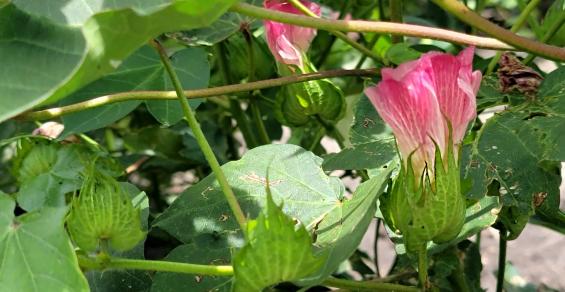Numerous issues have affected and will continue to affect cotton prices.
Predicting where cotton prices will go in a volatile economic environment challenges market analysts. But one thing that looks to be certain is that the 2022 cotton market will run through Texas.
Texas A&M AgriLife Extension Economist John Robinson says numerous issues have affected and will continue to affect cotton prices.
Post pandemic buying, strength of the dollar, rising costs of fuel, food, and other consumer goods all may affect the cotton market. So does Texas acreage and in-season weather.
In a recent market update webinar with Extension Economist Mark Welch handling grains, Robinson looked at the fundamentals behind the recent upswing in cotton prices.
See, NCC’s Gary Adams talks cotton planting, farm bill, exports
“Coming out of the pandemic, we saw a strong upward demand for cotton consumption and for retail sales all the way up and down the supply chain,” he said. “The [post pandemic] recovery was sharp and interpreted as a boom, which was reflected in the cotton market.”
That recovery, Robinson said, helped lift prices over the last 18 months.
“Also, a year ago people thought we were facing a drought -until it started raining last May and June of 2021.”
Assumptions of drought encouraged a lot of speculative buying. “A lot of bets were made that we would have a short crop, a short supply, and high prices in 2021. Speculators jumped in and bought the market up. That’s what took the market over a dollar in the first place — speculative buying following the pandemic recovery and increased demand.”
Bunch of business
More recently, Robinson said, “a whole bunch of cotton business kept cotton prices over $1.30, $1.40 and more than $1.50. It’s still hanging in there.
“A whole bunch of textile mills bought cotton from the 2021 crop. And when they take delivery, they’re buying back their hedges. Because so many of them did business this way, they created what they call mill fixation, buying back previous hedges.”
Another factor is the value of the dollar, which Robinson calls a headwind. “When the dollar gets stronger, which occurs when the economy is strengthening (a boom phase), the dollar tends to go up. It tends to go down during recessionary periods.
“When the dollar goes up, it’s a headwind to commodity prices, particularly commodities we export — cotton, wheat, and soybeans to some extent (some corn too). But cotton, wheat, and soybeans are more influenced by the value of the dollar.
“When the dollar is stronger, textile mills in China, change money into Brazilian currency and buy Brazilian cotton cheaper than they can U.S. cotton, all things being equal.”
Demand factor
Consumer demand plays a role. Cotton consumption goes down in a recession, Robinson said. “Cotton, more than grains, is a discretionary product. When times are tough, we can buy cheaper cuts of meat or eat peanut butter sandwiches, but we’re still going to eat. And we’re going to put gasoline in our cars and trucks. But we tend not to buy apparel during tough times.”
The market is still chugging along, Robinson said, influenced by that “mill fixation dynamic, a leftover factor from last year. Mill fixation was responsible for a lot of the upward movement from $1.10 to $1.40 to $1.50.
“This will fade when the July contract goes out,” he added. “The old crop marketing year will wind up and those ’21 crop export sales are finalized. They’ll buy back hedges, which may lead to some last-minute fireworks in June. We may get above $1.50, but when this is done, it’s done. But it won’t have much of an effect on the red line. It will not have much of an effect on new crop futures.”
He said new crop futures are supported by the drought impact — expectations of a short crop, a lot of abandonment, and whether we have a 16-million, a 15-million or a 14.5-million crop.
See, Cutting inputs too deep is risky strategy
Robinson said the new crop price is up, expecting drought. “However, I think a lot of cotton will be planted.”
Drought favors cotton
He said drought situations favor cotton over grains. “Growers tend to opt for cotton because if it comes up, they’re better off having a cotton crop in a dry situation than a grain crop. If it doesn’t come up, they’re better off having an insured cotton crop failure than an insured grain crop failure.”
What Texas cotton farmers plant and take to harvest will be a crucial factor.
“I think a whole bunch of Texas growers are putting cotton seed in the ground, buying expensive insurance on it, and waiting to see what happens,” Robinson said.
He noted that May rainfall across much of the Southwest cotton production area complicated the picture, “from an analyst’s standpoint. It is a big question mark in terms of cotton supply and demand outlook.”
He said the planted acres picture will come into sharper focus in July and August and later in the fall. “I bet it’s probably between 12 million and 12.5 million acres. The real question is what gets harvested. Right now, USDA is guessing that we’ll have 25% abandonment. That could be 30% abandonment. A lot of smart people think it probably will be 30%, but it remains to be seen.
“Last year was a good example, thinking ‘we’re in a drought, we’re going to lose a lot of these acres.’ But it started raining and a lot made it to harvest. So, we don’t know. And we won’t know until early fall.”
Production risk and the drought are the driving forces, especially in Texas. “It already has been,” Robinson said. “A lot of acreage in the Coastal Bend was damaged past the insurance adjuster window. Some of that has already been zeroed out. Some cotton might emerge with this last rain, but they’ve already lost production because of the drought.
“In the Southern Rolling Plains, the Northern Rolling Plains, the Panhandle, and the South Plains, drought will be the issue.”
He said conditions in Texas’ largest production areas can swing the whole U.S. production and the whole U.S. supply by 1.5 million bales, up or down.
Adding to the uncertainty is carryover, which Robinson said is tight, with USDA estimating 2.9 million bales. “That’s historically very tight and will support cotton prices above $1.10, probably until harvest. If we cut 1 million, 1.5 million, or 2 million off this number, ending stocks will be even tighter.
“If it’s tight or very, very, very tight, prices will be supported at $1.10 to $1.30 range. We’ll just have to see how high it goes.”
Marketing strategy
How should growers manage in this market environment? “It’s hard with this level of production risk,” Robinson said. “It’s hard to forward contract to capture those prices and obligate to deliver bales in an uncertain production environment.”
He said seasonal pools, especially on dryland acreage might make sense. “Hedging is expensive but offers an opportunity to buy $1.10 or $1.20 put options.”
Meanwhile, the cotton market tries to make sense of uncertainty. “It’s sitting there making the best guess that it can, but uncertainty will keep prices higher until it becomes clearer how much or how little we actually produced,” Robinson said.
And what Texas produces will be critical.
For more information on cotton markets, check Robinson’s newsletter at http://agrilife.org/cottonmarketing/.




